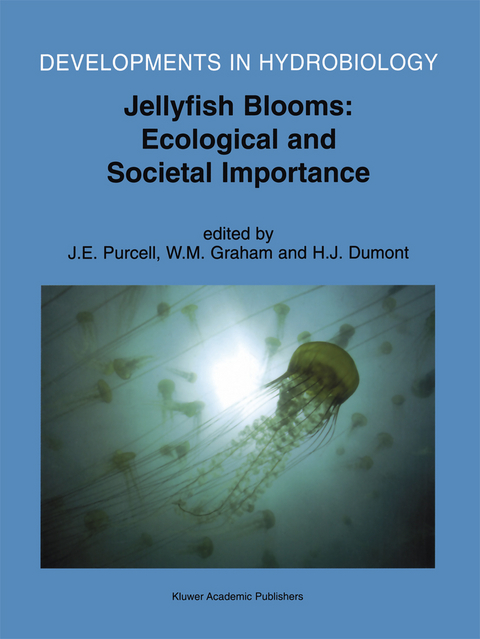
Jellyfish Blooms: Ecological and Societal Importance
Springer (Verlag)
978-94-010-3835-5 (ISBN)
`Jellyfish', a group that includes scyphomedusae, hydromedusae, siphonophores and ctenophores, are important zooplankton predators throughout the world's estuaries and oceans. These beautiful creatures have come to public attention as featured exhibits in aquaria and in news headlines as invaders and as providers of genes used in biomedical research. Nevertheless, jellyfish are generally considered to be nuisances because they interfere with human activities by stinging swimmers, clogging power plant intakes and nets of fishermen and fish farms, and competing with fish and eating fish eggs and larvae. There is concern that environmental changes such as global warming, eutrophication, and over-fishing may result in increased jellyfish populations.
The literature reviews and research papers in this volume explore the interactions between jellyfish and humans. Papers cover the medical aspects of jellyfish stings, jellyfish as human food and jellyfish fisheries, interactions of jellyfish and fish, effects of environmental changes on jellyfish, effects of introduced ctenophores on the Black Sea ecosystem, factors causing increases or concentrations of jellyfish, and others aspects of jellyfish ecology. This is an important reference for students and professional marine biologists, oceanographers, fishery scientists, and aquarists.
Jellyfish and Human Enterprise: Fisheries and Tourism.- Medical aspects of jellyfish envenomation: pathogenesis, case reporting and therapy.- Jellyfish as food.- Jellyfish fisheries in southeast Asia.- Interactions of pelagic cnidarians and ctenophores with fish: a review.- Feeding on survival-food: gelatinous plankton as a source of food for anchovies.- Jellyfish and Changing Ecosystems.- Jellyfish blooms: are populations increasing globally in response to changing ocean conditions?.- Pelagic coelenterates and eutrophication: a review.- Effects of low dissolved oxygen on survival and asexual reproduction of scyphozoan polyps (Chrysaora quinquecirrha).- Numerical increases and distributional shifts of Chrysaora quinquecirrha (Desor) and Aurelia aurita (Linné) (Cnidaria: Scyphozoa) in the northern Gulf of Mexico.- Timing and size of blooms of the ctenophore Mnemiopsis leidyi in relation to temperature in Narragansett Bay, RI.- The impact of El Niño events on populations of mesopelagic hydromedusae.- Jellyfish swarms, tourists, and the Christ-child.- The ctenophore Mnemiopsis in native and exotic habitats: U.S. estuaries versus the Black Sea basin.- Chemical composition, respiration and feeding rates of the new alien ctenophore, Beroe ovata, in the Black Sea.- The new invader Beroe ovata Mayer 1912 and its effect on the ecosystem in the northeastern Black Sea.- Physical/Hydrodynamic Interactions With Jellyfish.- A physical context for gelatinous zooplankton aggregations: a review.- Developing jellyfish strategy hypotheses using circulation models.- Flow and prey capture by the scyphomedusa Phyllorhiza punctata von Lendenfeld, 1884.- Jellyfish Reproduction and Population Biology.- Reproduction and life history strategies of the common jellyfish, Aurelia aurita, inrelation to its ambient environment.- In situ estimation of ephyrae liberated from polyps of Aurelia aurita using settling plates in Tokyo Bay, Japan.- Geographic variation and ecological adaptation in Aurelia(Scyphozoa, Semaeostomeae): some implications from molecular phylogenetics.- General Ecology of Jellyfish.- Observations on the distribution and relative abundance of the scyphomedusan Chrysaora hysoscella (Linné, 1766) and the hydrozoan Aequorea aequorea (Forskål, 1775) in the northern Benguela ecosystem.- A novel cilia-based feature within the food grooves of the ctenophore Mnemiopsis mccradyi Mayer.- Protistan epibionts of the ctenophore Mnemiopsis mccradyi Mayer.- Digenea parasites of jellyfish and ctenophores of the southern Atlantic.- Food and feeding of Aurelia aurita in Tokyo Bay with an analysis of stomach contents and a measurement of digestion times.- Distribution, abundance, behavior and metabolism of Periphylla periphylla, a mesopelagic coronate medusa in a Norwegian fjord.
| Reihe/Serie | Developments in Hydrobiology ; 155 |
|---|---|
| Zusatzinfo | XVIII, 333 p. |
| Verlagsort | Dordrecht |
| Sprache | englisch |
| Maße | 195 x 260 mm |
| Themenwelt | Naturwissenschaften ► Biologie ► Ökologie / Naturschutz |
| Naturwissenschaften ► Geowissenschaften ► Hydrologie / Ozeanografie | |
| Technik ► Lebensmitteltechnologie | |
| ISBN-10 | 94-010-3835-X / 940103835X |
| ISBN-13 | 978-94-010-3835-5 / 9789401038355 |
| Zustand | Neuware |
| Haben Sie eine Frage zum Produkt? |
aus dem Bereich


